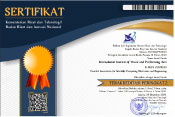(2) Sisca Rahmadonna
(3) Pujiriyanto Pujiriyanto
*corresponding author
AbstractThis study aims to analyze bibliometric trends and thematic relationships in studies on self-regulated learning and self-directed learning in music. Data collected from Scopus include 145 documents published between 2002 and 2024 and analyzed using Biblioshiny and VosViewer tools with the PRISMA approach. The results reveal six main thematic clusters that show a variety of research focuses. The first cluster highlights students' experiences and ease of use of learning technologies. The second cluster focuses on motivation, self-directed learning, and the integration of technologies such as artificial intelligence. The third cluster reviews the role of social robots in supporting self-directed learning. The fourth cluster discusses music teaching and education systems. The fifth cluster connects medical and psychological research with educational contexts, while the sixth cluster, the largest cluster, highlights humans as the main subject, focusing on music, psychology, and learning. This study contributes to understanding global trends, collaboration patterns, and main themes in the literature, as well as opening up opportunities for the development of self-directed learning strategies in music education.
KeywordsSelf-regulated learning; Music Education; PRISMA; Bibliometric; Self-directed learning
|
DOIhttps://doi.org/10.31763/viperarts.v6i2.1733 |
Article metrics10.31763/viperarts.v6i2.1733 Abstract views : 127 | PDF views : 19 |
Cite |
Full Text Download Download
|
References
[1] W. Li, P. Manoharan, X. Cui, F. Liu, K. Liu, and L. Dai, “The effects of musical feedback training on metacognition and self-directed learning,†Front. Hum. Neurosci., vol. 17, p. 1304929, Dec. 2023, doi: 10.3389/fnhum.2023.1304929.
[2] M. K. Dibenedetto, Connecting Self-regulated Learning and Performance with Instruction Across High School Content Areas. Cham: Springer International Publishing, 2018. doi: 10.1007/978-3-319-90928-8.
[3] D. Tahirbegi, “Higher music education students’ experiences and management of performance anxiety: A qualitative study,†Psychol. Music, vol. 50, no. 4, pp. 1184–1196, Jul. 2022, doi: 10.1177/03057356211034573.
[4] E. Allingham and C. Wöllner, “Slow practice and tempo-management strategies in instrumental music learning: Investigating prevalence and cognitive functions,†Psychol. Music, vol. 50, no. 6, pp. 1925–1941, Nov. 2022, doi: 10.1177/03057356211073481.
[5] C. Spahn, A. Immerz, A. M. Hipp, and M. Nusseck, “Social contact, practice, organization and technical knowledge: Experiences of music students in the course of the COVID-19 pandemic,†Front. Psychol., vol. 13, p. 885890, Sep. 2022, doi: 10.3389/fpsyg.2022.885890.
[6] S. Wang, “Empirical Study of Computer Application and Piano Teaching,†J. Phys. Conf. Ser., vol. 1533, no. 2, p. 022042, Apr. 2020, doi: 10.1088/1742-6596/1533/2/022042.
[7] M. S. Osborne, G. E. McPherson, P. Miksza, and P. Evans, “Using a microanalysis intervention to examine shifts in musicians’ self-regulated learning,†Psychol. Music, vol. 49, no. 4, pp. 972–988, Jul. 2021, doi: 10.1177/0305735620915265.
[8] J. L. Hatfield, “Performance profiling: A systematic approach to the enhancement of music practice and peak performance,†Music. Sci., vol. 28, no. 4, pp. 779–793, Dec. 2024, doi: 10.1177/10298649241252292.
[9] G. López-Ãñiguez and G. E. McPherson, “Using a music microanalysis protocol to enhance instrumental practice,†Front. Psychol., vol. 15, p. 1368074, Apr. 2024, doi: 10.3389/fpsyg.2024.1368074.
[10] D. Utermohl de Queiroz, G. López-Ãñiguez, and C. Foletto, “Investigating if and how string teachers instruct and support the self-regulation of students’ practice in online lessons,†Res. Stud. Music Educ., pp. 1–20, Jul. 2024, doi: 10.1177/1321103X241264943.
[11] B. J. Regier, “Examining Relationships Among Concert Band Directors’ Efficacious Sources, Self-Efficacy for Teaching Strategies, and Effective Teaching Skills,†J. Res. Music Educ., vol. 68, no. 4, pp. 436–450, Jan. 2021, doi: 10.1177/0022429420943137.
[12] G. E. McPherson, M. S. Osborne, P. Evans, and P. Miksza, “Applying self-regulated learning microanalysis to study musicians’ practice,†Psychol. Music, vol. 47, no. 1, pp. 18–32, Jan. 2019, doi: 10.1177/0305735617731614.
[13] J. Shin, “Self-directed Learning in Music Teacher Education: Perspectives from Pre-service Music Teachers in South Korea,†Malaysian J. Music, vol. 9, pp. 29–41, Sep. 2020, doi: 10.37134/mjm.vol9.3.2020.
[14] G. E. McPherson, J. Blackwell, and J. Hattie, “Feedback in Music Performance Teaching,†Front. Psychol., vol. 13, p. 891025, Jun. 2022, doi: 10.3389/fpsyg.2022.891025.
[15] W.-L. Huang and B. Song, “How do college musicians self-manage musical performance anxiety: Strategies through time periods and types of performance,†Int. J. Music Educ., vol. 39, no. 2, pp. 95–118, May 2021, doi: 10.1177/0255761421990800.
[16] E. T. Boon, “Self-regulated learning skills of prospective music teachers in Turkey,†Int. J. Music Educ., vol. 38, no. 3, pp. 415–430, Aug. 2020, doi: 10.1177/0255761420909919.
[17] M. Fujimoto and Y. Uesaka, “Autonomous or controlled interpreters? Model of Werktreue internalization for classical musicians,†Front. Psychol., vol. 15, p. 1401278, Jul. 2024, doi: 10.3389/fpsyg.2024.1401278.
[18] M. Aria and C. Cuccurullo, “bibliometrix: An R-tool for comprehensive science mapping analysis,†J. Informetr., vol. 11, no. 4, pp. 959–975, Nov. 2017, doi: 10.1016/J.JOI.2017.08.007.
[19] N. J. van Eck and L. Waltman, “Software survey: VOSviewer, a computer program for bibliometric mapping,†Scientometrics, vol. 84, no. 2, pp. 523–538, Aug. 2010, doi: 10.1007/s11192-009-0146-3.
[20] M. J. Page et al., “The PRISMA 2020 statement: An updated guideline for reporting systematic reviews,†Int. J. Surg., vol. 88, p. 105906, 2021, doi: https:10.1016/j.ijsu.2021.105906.
Refbacks
- There are currently no refbacks.
Copyright (c) 2024 Andini Isti Syafitri, Sisca Rahmadonna, Pujiriyanto Pujiriyanto

This work is licensed under a Creative Commons Attribution-ShareAlike 4.0 International License.
___________________________________________________________
International Journal of Visual and Performing Arts
ISSN 2684-9259
Published by Association for Scientific Computing Electronics and Engineering (ASCEE)
W: http://pubs2.ascee.org/index.php/viperarts
E: sularso@ascee.org
Organized by:
 This work is licensed under a Creative Commons Attribution-ShareAlike 4.0
This work is licensed under a Creative Commons Attribution-ShareAlike 4.0
























